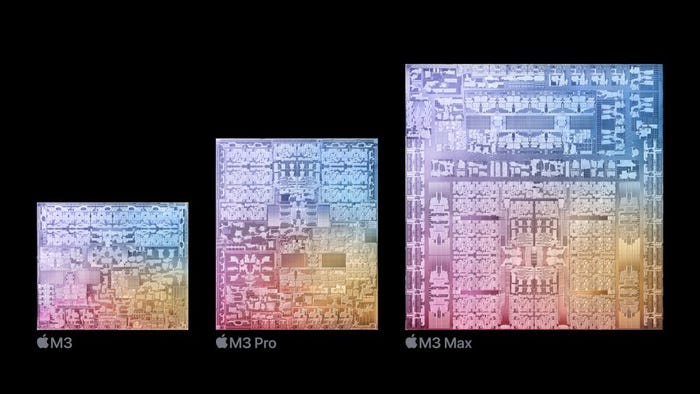Apple unveils its new range of M3 3nm PC chips
Tech giant Apple has announced its latest slate of silicon with the launch of the M3, M3 Pro, and M3 Max, which it claims are the first 3nm chips for a personal computer.
October 31, 2023

Tech giant Apple has announced its latest slate of silicon with the launch of the M3, M3 Pro, and M3 Max, which it claims are the first 3nm chips for a personal computer.
Apple says rendering speeds in the M3 chips are now up to 2.5 times faster than on the M1 family, the CPU performance cores and efficiency cores are 30% and 50% faster respectively, and the Neural Engine is 60% faster. Though it should be noted than in the numerous performance comparison stats it uses to illustrate the advancement of its chips, it sometimes compares the M3s to the two generation old M1 series, as opposed to the more recent M2.
All three versions of the new M3 chips, launched alongside new iMac and Macbook models, feature a GPU that Apple says represents the ‘biggest leap forward in graphics architecture ever’ for its silicon. The GPU comes with a new technology called Dynamic Caching, and brings new rendering features like hardware-accelerated ray tracing and mesh shading to Mac devices.
‘Game developers can use ray tracing for more accurate shadows and reflections, creating deeply immersive environments,’ claims the release. Despite their whopping price tags, Macs have never been seen as on par with top end Windows gaming PCs for performance so this may end up being a key marketing point.
The chips feature a unified memory architecture. Apple says having a single pool of memory within a custom package means all of the technologies in the chips can access the same data without copying it between multiple pools of memory, the significance of which is apparently improved performance and efficiency, and a reduced amount of memory a system requires for tasks.
Support for up to 128GB of memory ‘unlocks workflows’ previously not possible on a laptop, claims Apple, such as the sort of heavy number crunching required by AI developers.
The chips are obviously tiered in terms of performance, with the M3 being the most basic version featuring a mere 25 billion transistors — 5 billion more than M2. It has a 10-core GPU that is 65% faster than M1 for graphics performance, and an 8-core CPU – four performance cores and four efficiency cores – that is up to 35% faster than M1 for CPU performance.
In the middle is the M3 Pro stuffed with 37 billion transistors and an 18-core GPU, which is up to 40% faster than M1 Pro. Support for unified memory goes up to 36GB with this chip, and a 12-core CPU design offers single-threaded performance up to 30% faster than M1 Pro.
The most powerful of the three is the M3 Max which has 92 billion transistors, a 40-core GPU, support for up to 128GB of unified memory, and a 16-core CPU that’s up to 80% faster than M1 Max.

“Apple silicon has completely redefined the Mac experience. Every aspect of its architecture is designed for performance and power efficiency,” said Johny Srouji, Apple’s senior vice president of Hardware Technologies. “With 3-nanometer technology, a next-generation GPU architecture, a higher-performance CPU, faster Neural Engine, and support for even more unified memory, M3, M3 Pro, and M3 Max are the most advanced chips ever built for a personal computer.”
On one level this is simply providing some heavier processing firepower for the latest lineup of Apple’s laptop and desktop computers, and with the premium price points they have always commanded you’d expect them to be packing some decent grunt under the hood.
In the wider context of the wider PC CPU chip landscape, its more sign of disruption to a market which for years it felt like Intel and to a lesser extent AMD had sewn up with x86 technology.
Last week, Qualcomm unveiled the Snapdragon X Elite, its first dedicated, high-end PC chipset. Based on custom Arm architecture, Qualcomm claims it offers a 2x improvement in processing speed compared to x86 CPUs. It also claims the chip has 2x the on-board graphics processing power, better battery life, and AI capabilities which mean it can run large language models with over 13 billion parameters, and process 30 tokens – a sort of currency that users pay to run queries on an LLM – every second.
Meanwhile GPU specialist Nvidia has also begun designing Windows PC CPUs based on ARM architecture, two sources familiar with the matter told Reuters last week. These sources also claim that AMD also plans to make chips for PCs with Arm technology.
Get the latest news straight to your inbox. Register for the Telecoms.com newsletter here.
About the Author(s)
You May Also Like











_1.jpg?width=300&auto=webp&quality=80&disable=upscale)


.png?width=800&auto=webp&quality=80&disable=upscale)